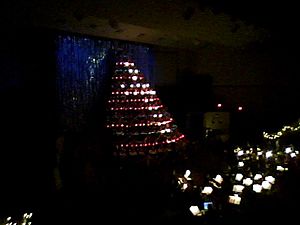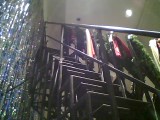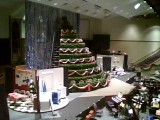Singing Christmas Tree facts for kids
A Singing Christmas Tree is a special kind of artificial Christmas tree that holds a choir of singers! It's also known as a Living Christmas Tree. These unique trees are often part of nativity plays, which tell the story of Christmas.
Imagine a giant cone-shaped structure made of steel. This structure is covered with artificial Christmas tree branches. Inside, there are special platforms where between 30 and 450 singers can stand. Churches and communities often build these trees for their Christmas celebrations.
The very first Singing Christmas Tree appeared outdoors in 1933 at Belhaven University in Mississippi. Later, in 1941, the first indoor tree was used at West High School in Denver, Colorado. The idea then spread, reaching places like Canada, the Philippines, South Korea, Switzerland, and Sri Lanka. One of the biggest Singing Christmas Trees is in Knoxville, Tennessee, which had 60,000 people come to see it in 2007!
Contents
How Singing Christmas Trees Started
Christmas trees first came to the United States in the 1740s with settlers from Moravia (now part of the Czech Republic). In 1851, the first place to sell Christmas trees opened in New York City. Later, in 1856, President Franklin Pierce put up the first Christmas tree in the White House.
Artificial trees were created in Germany in the 1800s. People were worried about cutting down too many trees and also about fire safety. By the 1960s, artificial trees became very popular in the United States.
The History of Christmas Caroling
Singing Christmas carols started in Europe in the 1200s. People sang about the birth of Jesus. Caroling continued until the Protestant Reformation (1517–1648), which stopped some religious carols in places like England. Even though they were sometimes banned from churches, people still sang carols at home or while visiting neighbors for charity.
Caroling became less common between 1660 and the 1800s. But by 1878, the Church of England helped bring it back. They combined carols with Bible readings in a special church service called "Lessons and Carols." Caroling has continued to grow in popularity in Europe and the United States, becoming a big part of Christmas music.
The First Singing Christmas Trees
A tradition in homes was to sing carols around the Christmas tree. In 1933, Belhaven University (then Belhaven College) in Jackson, Mississippi, had the very first "Singing Christmas Tree" outdoors.
The first indoor Singing Christmas Tree was in December 1941 at West High School in Denver, Colorado. Fifty students, dressed in choir robes and decorated with ornaments, stood on a wooden frame shaped like a tree. They sang nine Christmas carols for a school assembly. This tree became famous! During World War II, pictures of it were in many newspapers. Soldiers from all over the world wrote letters about how beautiful it was. Years later, a life-size photo of the tree was even shown in New York's Rockefeller Center.
The idea of using the tree for Christmas outreach (sharing a message with the community) started in 1963 in Van Nuys, California. The first steel-framed tree with special steps for the choir was built in 1972 by Millard Heath Specialties in Denton, Texas. This company has built over 200 "trees" for churches in many different places.
Singing Christmas Trees are now found in many countries. Some examples include Pampanga, Philippines; Suwon, South Korea; Winnipeg, Manitoba; Yarmouth, Nova Scotia; and Zurich, Switzerland.
How Singing Christmas Trees Are Built
Singing Christmas Trees are built to hold 30 to 450 singers. They can be 18 to 48 feet (about 5.5 to 14.6 meters) tall for indoor use. They can also be custom-made for outdoor events. These trees can be circular or shaped like a part of a circle (120, 150, or 180 degrees). Some trees even have seating for choir members with special needs.
The trees are covered with artificial, fireproof evergreen branches and Christmas lights. This makes them easier to set up and take down. Besides lights, they have controls that allow a main control center in a church or community building to manage the show.
For example, a tree in Huntsville, Alabama, holds 150 singers and is 30 feet (9.1 meters) tall. If you include the star on top, it's 39 feet (11.9 meters) tall! It uses a lot of electricity during its performances and weighs 6,000 pounds (about 2,720 kilograms). It's made from 377 pieces of steel, has 7,500 pieces of artificial greenery, and over 13,000 lights!
Singers in the Tree
When arranging singers in the tree, it's best to have an equal number of men and women. The higher voices, like sopranos, usually stand at the top of the tree. The middle voices, like altos and tenors, are in the middle. The lower voices, like bass singers, are at the bottom. Male choir members are generally placed in the middle of the tree.
Singers who need to sit during the performance are usually in the bottom two rows. People who are afraid of heights (acrophobic) are also placed near the bottom. Singers who are afraid of small or enclosed spaces (claustrophobic) stand on the outside edges of the tree. Most choir members stand for the entire performance.
The Tree as Part of a Christmas Show
Many Singing Christmas Trees are part of larger nativity plays or nativity scenes. These shows celebrate Christmas and the birth of Jesus.
Famous Singing Christmas Trees
Here are some well-known Singing Christmas Trees:
- The Belhaven College Tree is the oldest, starting in 1933.
- The Capital Christian Center in Sacramento, California, celebrated its 60th Singing Christmas Tree in 2016.
- The Singing Christmas Tree in Portland, Oregon, began in 1962.
- Thomas Road Baptist Church in Lynchburg, Virginia, uses special lights that change colors and designs. These lights are perfectly matched to the music.
- Carolina Voices in Charlotte, North Carolina, has four groups of singers outside their tree to share the Christmas message.
- Sevier Heights Baptist Church in Knoxville, Tennessee, started their tree in 1989. It grew so popular that it moved to bigger venues. In 2007, 60,000 people saw their tree in five performances!
- Bellevue Baptist Church in Tennessee celebrated its 41st year in December 2016.
- In 2009, several trees celebrated their 25th year. These included trees at Ozark Christian College (Joplin, Missouri), United Baptist Church of Ashland, Kentucky, and First Baptist Church of Huntsville, Alabama. The First Baptist Church of Montgomery, Alabama, celebrated its 30th year in 2009.
- Mona Shores High School in Michigan has "America's Tallest Singing Christmas Tree." It features about 300 singers and a live symphony orchestra.
- "Den Sjungande Julgranen" (The Singing Christmas Tree) in Gothenburg, Sweden, started in 2004. It's an outdoor show for the city that runs for three weeks in December. It features different choirs, choreography, and percussion.







